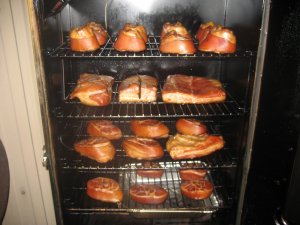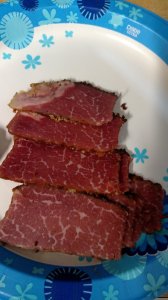real simple curing brine:
for every 1 gallon of water, add:
1/3 - 1 cup sea salt (depending if you're on a lo-salt diet)
1 cup granulated sugar or Splenda[emoji]174[/emoji]
1 cup brown sugar or Splenda[emoji]174[/emoji] brown sugar mix
1 tbsp cure no. 1 pink salt
stir thoroughly until clear amber color, pour over meat, inject if necessary to cure from inside-out as well as outside-in
weight down with a partially filled 1 qt or 1 gal. ziploc bag or bags to keep meat immersed
Curing times vary with meat, but generally overnight to 2-3 days for chickens and turkeys, 8-10 days buckboard bacon, 10-14 days belly bacon, pork shoulder, whole butts, 3-4 weeks whole hams, 10-20 days corned beef (fresh beef roasts, briskets, rolled rib roasts, etc.) If whole muscle is more than 2" thick, then inject so it can cure i/o as well as o/i, and/or in and around bone structures, etc.
You can add any other flavorings you'd like, this is just the basic curing brine. 1 heaping tablespoon of cure is about 1 ounce. The maximum concentration allowed safely is 3.84 ounces per 1 gallon of brine (24 lbs.per 100 gallons: 16 oz. x 24 = 384 ounces, 1/100th is 3.84 ounces). You can experiment with different concentrations as long as you keep it between those parameters:
In an effort to standardize this process (for me), I first read through all 461 previous posts in search for a specific answer. Due to having used dry cures in the past I am used to weighing things in grams for accuracy. I know that a cup of granulated sugar and brown sugar both weight the same at 200 grams. I know that a cup of table salt weighs 273 grams vs a cup of Kosher Salt at 288 grams.
My question is the curing salt. If a person were to Google how many grams in a Tablespoon they could get an answer of 28.34 grams. When using a calculator such as the one found at traditionaloven.com and using the 1 Tablespoon of table salt volume to grams the answer is 17.06 grams in table salt mass. While both of these answers well below the 3.84 ounces/gallon, which one is correct?






